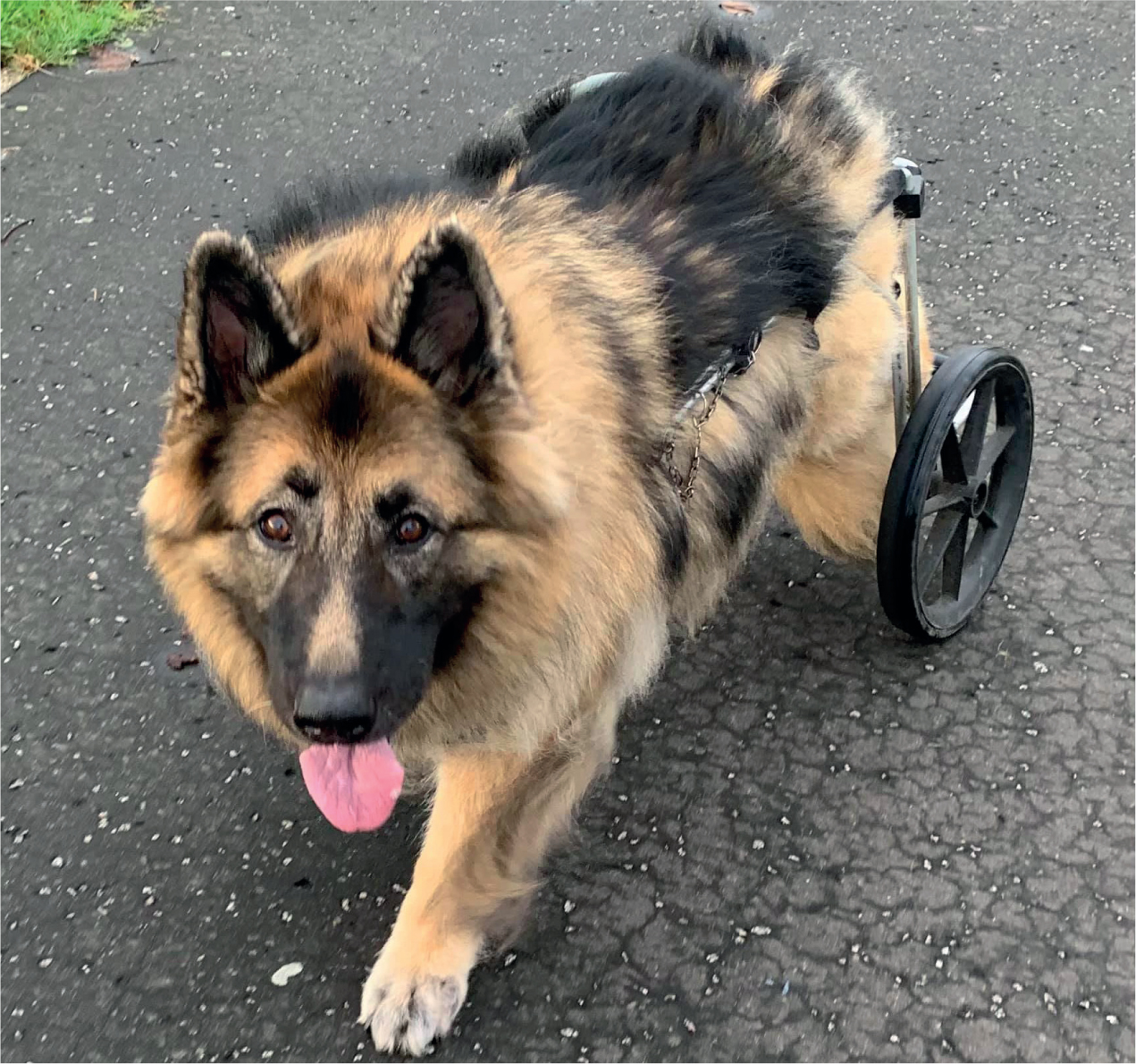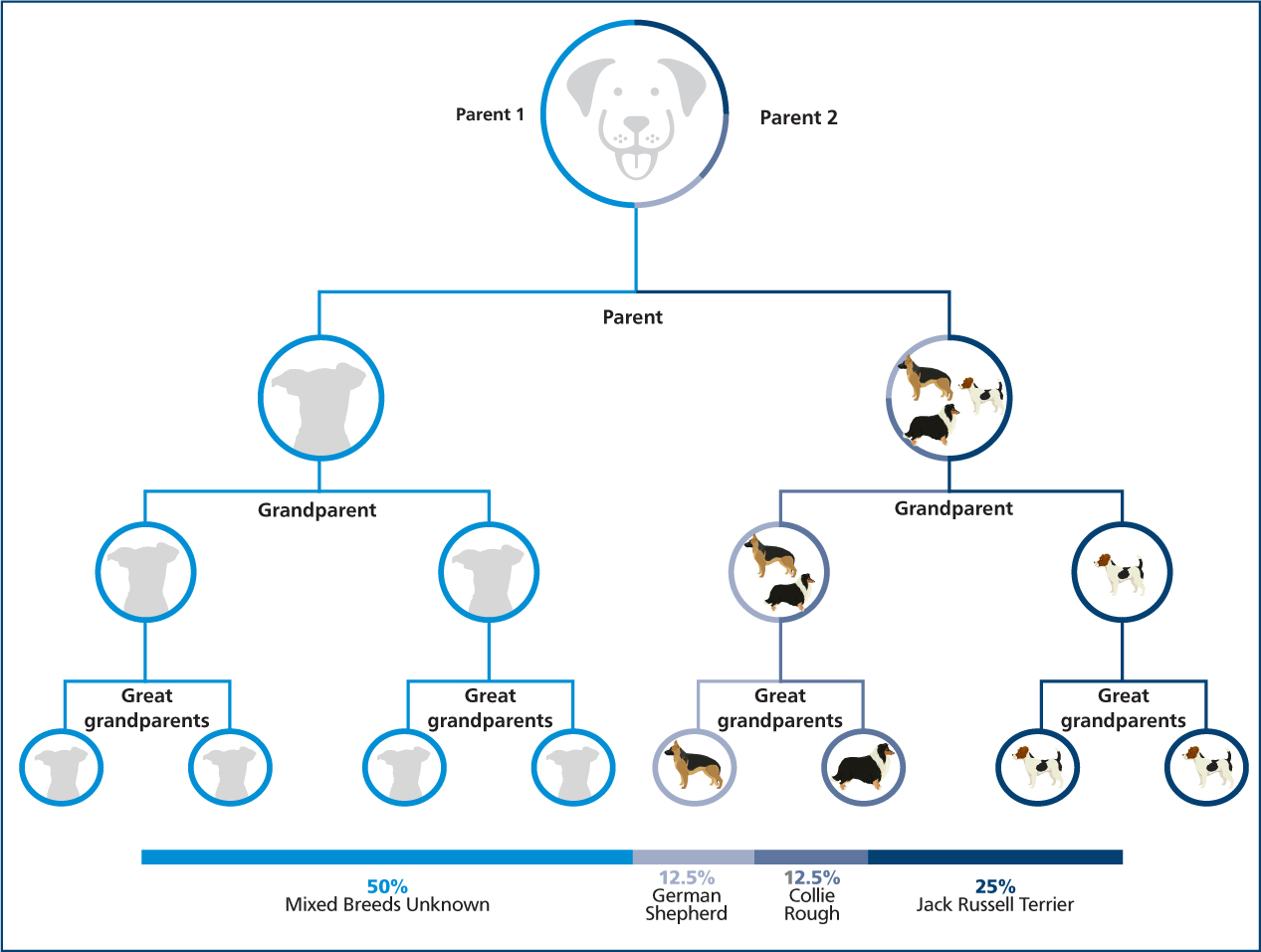The canine genome contains approximately 2.5 billion base pairs of DNA. It was fully sequenced for use by biomedical and veterinary researchers around the world in 2004 (National Human Genome Research, 2012). Many breeds of dog are prone to genetic disease, including forms of heart disease, blindness, deafness and autoimmune disease, as a result of mutations in these DNA base pairs. Most inherited disorders are breed specific and involve single gene defects, passed on through Mendelian inheritance, which is the simplest form (Slutsky et al, 2013). The sequencing of the canine genome has greatly increased the ease with which tests for inherited disease, occurring as a result of single-gene mutations, can be developed. There are now a huge number of tests widely available for the easy detection of such conditions (Sampson, 2011).
Veterinary practice today
Currently, these tests are most often used in veterinary practice to confirm a suspected diagnosis in an animal presenting with symptoms of the disease. However, they are becoming increasingly used by breeders in an attempt to exclude dogs containing specific genetic mutations from the gene pool, so they will not be used in breeding.
Media publicity
There has been much interest in the media about screening newborn babies for genetic disease. Known as DNA profiling, there are many arguments for and against such tests. Those for DNA profiling believe that healthcare provision will be improved for individuals with genetic disease; that medical research for pharmaceuticals could be improved, and that lifestyles could be modified in individuals who may be known to be at high risk of developing medical conditions later in life. Those against argue that individuals may face discrimination for employment or insurance provision; that ethically it is a step towards creating a ‘superior’ race, and that there may be a psychological impact on individuals being informed about any genetic condition they may go on to develop (Justice et al, 2005).
Potential use
In canine and feline patients, many of the arguments against testing do not apply, as the emotional impact of being aware of the likelihood of developing a condition is not relevant for the patient, nor is the moral and ethical dilemma over genetic selection, as this has been exercised in an attempt to improve canine health for decades. However, the positive arguments stand true — it could allow for the provision of better healthcare for pets, enable owners to implement lifestyle adaptations from the time of diagnosis and enable better management, or even prevention, of the development of a potential future condition. It could also allow for the potential to eradicate certain genetic disorders from the gene pool, by only selecting unaffected individuals to breed from.
Nationwide DNA profiling
Nationwide Laboratories have used developments in the availability of gene tests to develop DNA profiling. This can be used as a means of detecting the risk of a pet developing genetic disease later in life, before they show any clinical signs, in order to offer these advantages to the owner and veterinary practice. There is the option to include a life plan with the test results — a unique feature that allows owners the opportunity to provide ultimate management of their pet's condition, throughout their life. Nationwide Laboratories offers genetic testing in collaboration with Orivet.
Orivet also offer breed identification, which is used to determine the heritage of cross-breed dogs. This can be interesting for the owner, as it may help explain a dog's temperament and allow for a better understanding of the necessary training and exercise requirements. This can also allow for further screening for the genetic conditions that are linked to individual breeds. The information used to determine the genetic breed make-up of crossbreed dogs was gained through research that analysed more than 48 000 single nucleotide polymorphisms (SNPs). This demonstrated that domestic breeds share a higher proportion of haplotypes, which are a group of genes inherited from a single parent (vonHoldt et al, 2010).
The genetic information gained from a sample sent to Orivet is analysed using a computer algorithm, to determine the most likely breed make-up. The company estimates there is 95% accuracy rate when analysing breed heritage for purebred dogs, and 80–90% for crossbreeds.
There are five types of test that can be offered (Table 1). These tests are performed by a member of the veterinary practice and involve taking a buccal swab from the patient and submitting it to Nationwide Laboratories. They should expect to receive the result around 4–6 weeks after submission. The sampling and submission process is incredibly straightforward and is performed by carrying out a series of easy to follow instructions.
Table 1. DNA profiling packages offered by Orivet
| Test | Description |
|---|---|
| Dog breed ID and life plan | Ideal for mixed breeds, this helps to find out the pet's breed makeup and identify potential health risks, to help schedule recommended veterinary interventions over the entire lifetime of the animal |
| Dog health screen and life plan | Perfect for purebreds and dogs with known breed makeup. The dog's DNA is screened for genetic disease and physical traits, the owner then receives a schedule of recommended veterinary interventions over the entire lifetime of the animal |
| Dog breed ID, health screen and life plan | This is a comprehensive test for mixed breeds. The dog's DNA is screened for genetic disease and physical traits, the owner then receives a schedule of recommended veterinary interventions over the entire lifetime of the animal |
| Cat health screen and life plan | Available for known cat breeds, the Domestic Short Hair and Domestic Long Hair. The cat's DNA is screened for genetic diseases and physical traits, the owner then receives a schedule of recommended veterinary interventions over the entire lifetime of the pet |
| Dog breed ID | This test helps to identify the dog's breed makeup |
Samples can be taken from animals of any age but the screening of young animals is likely to be most beneficial to the patient, as any recommended lifestyle adaptations or treatment can be administered over the lifetime of the pet.
Improving healthcare for the future
An example of a genetic condition, where knowing about the condition early in the animal's life could allow for better healthcare provision, is von Willebrand disease. This is the most common inherited coagulopathy in dogs — estimated to affect 1.5% of the population (Keeshen et al, 2017). It is particularly associated with the Doberman Pinscher, although it has been identified in 54 breeds (Crespi et al, 2018). It is a deficiency defect relating to a lack, or absence of the von Willebrand factor (type 1, 2 or 3), a protein that has several actions within the clotting cascade. These functions include acting as a molecular bridge between platelets and endothelium, and assisting with collagen and platelet binding, as well as for interactions with, and stabilisation of, the clotting factor VIII (Crespi et al, 2018). The clinical signs of von Willebrand's disease vary, some dogs show spontaneous bleeding, whereas others show no signs of this and are only suspected to have a clotting disorder after persistent bleeding post-surgery or trauma, which could be life threatening. Identification of the condition in the animal as a puppy could allow for preventative measures to be taken before surgery. These include the pre-surgical administration of desmopressin for type 1 patients, as it increases release of von Willebrand's factor, or plasma, or the selection of a less invasive surgical technique, such as laparoscopic ovariectomy, to lower the risk of perioperative haemorrhage (Keeshen et al, 2017).
Treatment planning
Knowledge of the likelihood of development of a hereditary condition, such as degenerative myelopathy (Figure 1), could assist with early treatment interventions including physiotherapy and photobiomodulation, both of which have been shown to increase survival time in affected individuals (Kathmann et al, 2006; Miller et al, 2020). Degenerative myelopathy is a chronic, debilitating condition which starts with affected patients displaying mild proprioceptive deficits of the hind feet, progressing to eventual tetraparesis if euthanasia does not take place before this point (Kathmann et al, 2006). The condition does not normally present until affected individuals are around 8 years of age (Awano et al, 2009). As a result, the mild symptoms present in the initial stages are often mistaken for alternative conditions or comorbidities that commonly affect large breed dogs around this age, such as osteoarthritis or spondylosis, so the condition could continue undiagnosed for some time. Degenerative myelopathy can now be screened for, by checking for the presence of the superoxide dismutase 1 on chromosome 31 (Awano et al, 2009). The presence of the genetic mutation does not mean the animal will definitely go on to develop the condition, but is suggestive of an increased likelihood. Genetic information about a young animal's likelihood of developing this disease could allow for early diagnosis, so that the best treatment plan is selected without delay.

Breeding
DNA screening of potential sires has become extremely important to attempt to eliminate some forms of genetic disease, through breeding. One such condition is a form of progressive retinal atrophy (PRA) known as PRA-rcd3 in the Cardigan Welsh Corgi (Figure 2), which causes blindness in young adult dogs (Palanova, 2016). From 1 January 2015, the Kennel Club will only register puppies that have been born as a result of mating between two parents that have been gene tested and are clear of PRA-rcd3 (The Kennel Club, 2020). There is massive potential for breeders to use DNA profiling on young litters and know, before rehoming, which pups to retain for breeders and which to advise against breeding. Profiling can be used for this condition and others, to improve the health and reduce inherited disease, among multiple breeds.

Potential drawbacks
Although a huge number of benefits exist for DNA profiling, potential disadvantages in the future lie in the possibility of pet insurance companies allowing this information to affect the level of cover, or premiums for policy holders. A recent phone survey, conducted by Nationwide Laboratories among the biggest pet insurance companies, showed that DNA profiling should not affect pet insurance policy, which is breed specific, as insurance companies are already aware of key traits by breed. However, it is always worth checking on case-by-case basis. There are also limitations for detecting conditions such as hip dysplasia, which have a more complex inheritance through multiple genes and environmental factors (Ginja et al, 2015).
Case studies
Izzy
Izzy, a 7-year-old female neutered mixed breed dog (Figure 3), was brought over to the UK from Greece when she was 1 year old. Her owners have always been curious about her breed ancestry and were keen to submit a buccal swab to Nationwide Laboratories to find out.

Izzy's results (Figure 4) demonstrate that parent 1 is a ‘mixed breed’. This means that with the technology available today, the genetic breed makeup cannot be narrowed down further than the genetic ‘group’ level. This is likely a result of parent 1 being bred from several generations of mixed breed dogs.

Parent 2 is shown to be 50% Jack Russell Terrier, 25% Rough Collie and 25% German Shepherd.
Alongside Izzy's breed ancestry results, based on the breeds included in her genetic makeup, her age, weight, lifestyle factors and her health risks could also be determined. There was a list of ten conditions she is at increased risk of developing, when compared with published scientific information. The list was generated by a proprietary algorithm, taking into account Izzy's breed makeup, weight, sex and other lifestyle factors from information provided.
- Allergy and atopic dermatitis
- Cardiomyopathy
- Cataract
- Cerebellar abiotrophy
- Dermatomyositis
- Gastric dilation and volvulus
- Haemophilia A (factor 8 deficiency)
- Hip dysplasia
- Multi-drug sensitivity
- Osteochondrosis.
The estimated prevalence of each condition was recorded, alongside information on each of the conditions and any screening tests (genetic or otherwise), which could be used to check for the presence of each of the conditions she is at an increased risk of developing.
Among the list of conditions, Izzy has been shown to be at increased risk of multi-drug sensitivity (MDR-1) with an estimated prevalence of 1 in 3. This is a genetic mutation of the MDR-1 gene, which makes affected dogs particularly sensitive to drugs including ivermectin and loperamide. The MDR-1 mutation results in an inactive P-glycoprotein protein, which is normally responsible for pumping drugs and toxins from the cerebrospinal fluid back into the circulation, forming part of the blood/brain barrier and protecting the brain. The inactive P-glycoprotein in dogs with the MDR-1 mutation allows drugs and toxins to accumulate in the cerebrospinal fluid, causing seizures or even death in some cases (Firdova et al, 2016). Izzy was given a one in three estimated risk of possessing this gene mutation. There is a gene test available to screen for presence of the MDR-1 mutation, so Izzy's owners have the option of screening her, or avoiding drugs that could cause these types of sensitivity reactions such as ivermectin, to minimise her risk.
Sophie
Sophie is a 6-year-old Large Munsterlander weighing 25 kg.
Her results gave Sophie's owners a detailed overview of the Munsterlander breed, including a general description and history, as well as information about her behaviour, temperament, requirements and needs.
Her owners were then provided with a list of ten conditions that Sophie may be prone to and information about each of them. They included:
- Elbow dysplasia
- Hip dysplasia
- Gastric dilation and volvulus
- Allergy and atopy
- Otitis externa
- Epilepsy
- Cataract
- Osteochondrosis
- Black hair follicular dysplasia
- Urolithiasis.
This information could allow for Sophie's owners to conduct lifestyle planning. This could involve managing her diet, exercise and body condition, to ensure that the environmental factors that increase the likelihood of developing orthopaedic conditions, such as hip and elbow dysplasia and osteochondrosis, are well controlled. It also alerted her owners to her risk of gastric dilation and volvulus, making them more vigilant in ensuring Sophie is not exercised soon after eating.
This information could highlight the importance of regular check-ups by Sophie's veterinary surgeon, to assess her skin, ears and eyes (and urine if necessary). This will ensure that if there are any signs of developing atopy, otitis, cataracts or uroliths, that they are detected early to allow for better treatment or management.
Sophie was screened for 112 genetic diseases and found to be clear for all. This information would not only put her owners’ minds at rest in terms of the likelihood of her developing inherited disease (those that can be screened for), it also confirms her as a good choice to breed from if her owners were considering this.
Information on lifestyle planning was supplied to Sophie's owners. This included feeding advice, including the type of food she should be fed, as well as her likely daily caloric requirement. This information could be used to assist with management of her body condition, which is important given the conditions her genetic information suggests she may be prone to.
By inputting information about Sophie's vaccination status and parasite control her owners can plan when future treatments are due, to ensure her comprehensive preventative healthcare is optimised.
Lady Penelope
Lady Penelope is a 9-year-old Domestic Short Hair cat.
Her owners were given information on the Domestic Short Hair cat, including information about breed history, temperament, behaviour, requirements and needs.
Next, they were given information on her health risks. The 10 conditions that Lady Penelope may be at risk of developing, when her information is compared to published scientific information available, was provided. These diseases included:
- Chronic kidney disease
- Urolithiasis
- Osteoarthritis
- Chronic bronchial disease
- Hypertrophic cardiomyopathy
- Diabetes mellitus
- Hyperthyroidism
- Lymphoma
- Gingivitis and periodontal disease
- Inherited/congenital deafness.
A detailed explanation about each disease, including their clinical signs, was provided to Lady Penelope's owners. This information will allow for an increased awareness of changes to look out for, particularly as Lady Penelope ages. The Code of Practice for the Welfare of Cats is a document that was released initially in 2006, with the intention of improving the welfare of cats kept as domestic pets. One of the sections discussed is the difficulty of detecting pain and illness in cats. (Department for Environment, Food and Rural Affairs, 2017). Cat owners that receive Nationwide DNA results are provided with information on the various disease processes responsible for causing illness and pain, including their subtle clinical signs, and so will be educated on what to look out for. This will allow for earlier veterinary intervention, helping to improve feline welfare standards.
Lady Penelope was screened for 20 genetic diseases and found to be clear of all of these.
Finally, Lady Penelope's owners were given a lifestyle plan for her. This information includes details of her nutritional requirements, how best to feed her (an element also discussed in the Code of Practice for the Welfare of Cats) and information on routine preventative healthcare. Here, the importance of routine preventative care is discussed, together with when she is next due for treatment, based on the information provided by her owners.
Conclusions
DNA profiling, particularly of young animals, allows for the possibility of the veterinary practice to improve healthcare provision and treatment planning, using life plans for the individual patient. It can also improve the gene pool of pets and will hopefully have a huge impact on the number of animals suffering from inherited disease. The potential for these benefits to improve animal welfare standards is huge,.With the frequency of developments in the number of conditions that can be tested for, DNA profiling has an even wider scope for improving the future health of our pets.
KEY POINTS
- Sequencing of the canine genome has enabled researchers to create a wide number of genetic tests for inherited defects.
- DNA profiling involves screening young pure-bred animals for conditions that their breed may be prone to developing.
- Cross-bred animals can also benefit from breed ID tests to determine the pet's genetic makeup, before screening for potential inherited disease risks.
- DNA profiling in this way can determine whether the patient is at risk of developing inherited disease, and allow for better healthcare provision, treatment planning and prevention of breeding from affected individuals.
- This has the potential to improve the healthcare of both the individual animal and for the future population.


